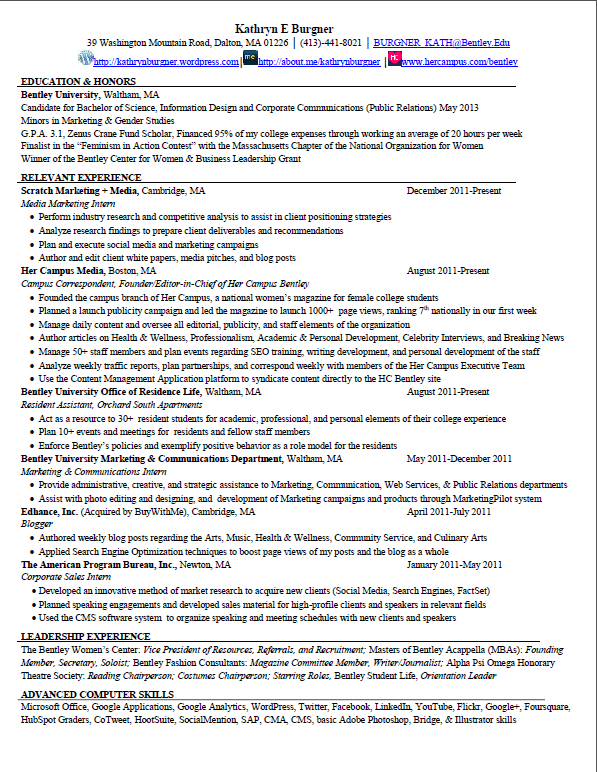Your resume is the key to the front door of your dream internship. It’s the first step in gaining an interview for the career position you’ve been working hard to get to through all your college classes. Along with networking, researching the company, and being a great interviewee, your resume can make or break your chances of getting an offer. I’ve obsessed over perfecting my résumé during my time in college and I’ve worked on my résumé skills with Bentley University’s Career Services office (ranked #8 in the nation by the Princeton Review).
Here are the tricks of the “resume” trade that I’ve been taught:
Step One – Start With the Format: “Look and Feel”
- Just like with your job interview outfit, your skills and experiences should make your resume stand out—not your crazy fonts, colors, and formats.
- Keep your resume in one font throughout and ensure that the spacing is consistent and even, both from top to bottom and from left to right with indentations. Also, aim to keep your resume to one page.
- Resist the urge to put your name in a fancy, curly signature font, as it can become hard to read. Instead, bold it or make it a size point larger than the rest of the document.
- Using line dividers and bullets can help draw the reader’s eyes to the important parts of your resume. If your resume is organized and professional-looking, then the reader might assume that you’re organized and professional, as well.
Step Two – Name and Contact Information
- When you’re in college and are constantly moving between home and school, it may seem like a good idea to put both your school and home address. However, this can be confusing to employers and may be redundant if you list your school’s city and state below.
- Include your home, or permanent, address and the email/phone that you will use to communicate with the employer.
- If you have a personal website or blog (not your Facebook account), then place it under your name and contact information. Especially if you have online writing samples, it’s a great idea to show your presence on the web.
Step Three – Use Powerful Section Headers
- Section headers allow your resume to be neatly divided into different categories of qualifications and experiences.
- Based on your areas of expertise, section headers can be unique and tailored to the areas that help describe you the best.
- Sample section headers are: “Education”, “Honors”, “Relevant Work Experiences” or “Past Work Experiences”, “Other Work Experiences”, “Leadership Experience”, “Community/Service Experience”, “Interests”, and “Skills”.
- Section headers should be in capital letters or bold typeface to allow them to pull attention and show their hierarchy. If you want to draw line dividers, then drawing them after each section header can be effective.
Step Four – Perfect Your Descriptions
- While the position title and company name are important, your descriptions are what prospective employers will go to. What spectacular work did you do and what contributions did you make at your last position? This is what employers want to know.
- If you’re currently working at a job (“January 2012-Present”, for example), then your description bullet points should be in the present tense. For example, “Take inventory of store merchandise each day.” If you’ve left the job and it’s a past experience, then your descriptive points should be in the past tense.
- Make your descriptions concise and powerful. Using industry lingo and specific software names shows that you paid attention while completing the task. Consolidate your tasks as much as possible to showcase the most important features of your position without rambling.
- Try to keep each description point to one line, as it condenses space and looks less wordy.
Step Five – Showcase Your Skills
- Especially if you’re going into a field with specific software or technology demands, you’ll want to list your skills in terms of any applications or programs.
- Start with the basic technology skills, such as Microsoft Office and programs you’ve used in class. However, if you aren’t proficient or knowledgeable about a program, then it’s better to leave it off. If you list “Photoshop” in your skills section, then your employer will expect you to have mastered the Photoshop concepts needed for the job.
- If you’re going into a Marketing or Communications field, then listing your skills with social media applications is important (even if it seems too basic to you).
Step Six – Make Your Resume Industry-Specific
- Using industry lingo and referring to skills expected in your selected industry can make your resume standout, especially among internship-seekers.
- If you’re interested in a few different industries, then making different versions of your resume for the different industries can help you showcase the right experiences for the right position. While it may seem time-consuming, it will help you save time and get ahead in the long-run.
Step Seven – Represent Your Resume
- An awesome resume will catch an employer’s eye, but your personality and networking skills need to do the talking. Make sure that you know your resume by heart – if a position or experience is in the document, then you need to be able to talk about it and elaborate.
- After applying for a position and submitting your resume, be prepared to talk “on the fly” at any time about your qualifications and interest in the position. While some companies do schedule phone interviews, others will just call you without notice to chat. Keeping a document on your desktop with your research about the company and the position can be helpful in unexpected phone interviews.
- Lastly, portraying a consistent “brand image” is important when it comes to your resume and job-seeking experiences. Stapling your business card to the corner of your resume can give the document the boost it needs for looking professional and “branded.” Posting your resume online and making sure it’s consistent with your LinkedIn profile can get your “brand” out there.
Update, proofread, update proofread! As you gain more experience and skills, it’s essential to add to your resume and think of it as a “working document” that’s always changing. Proofread your resume as much as possible both with your own eyes and by asking others to take a look at it.
While these tips have worked out for many job-seekers before you, it’s important to remember that resume creation isn’t “one size fits all.” If it makes sense for your “personal brand” or specific industry to break a rule listed above, then give it a try.
May your resume be your key to the internship or job of your dreams!
*Sources:




